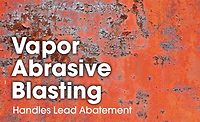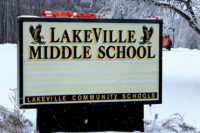In July of 2014, a small fire broke out inside of a gun range within the metro-Detroit city of Livonia. While the fire damage itself was minimal from a structural perspective, the entire facility was compromised by one hazardous substance – lead. As gun ranges are high-lead environments as it is, the fire only made matters more complicated, dispersing lead throughout the entire facility and forcing its immediate shut-down.
Rainbow International of Monroe is a full-service restoration company, which is why owner Jason Kitts received the call for the job. But as Kitts admits, he and his team initially knew nothing about lead abatement. Before starting the gig, he and his team completed the extensive certification course, along with the insurance adjuster and the gun range owner, in July 2014. This also included a four-hour lead awareness course before work began at the gun range in early August.
The gun range was a large one, which consisted of four main parts – a large warehouse portion in the back of the facility, the gun range itself, a showroom and retail center and, finally, a front office area. As testing verified, this wasn’t going to be an easy in-and-out – HEPA vacuuming and encapsulation was going to be required throughout the facility, as the yellow lead dust had been distributed throughout just about every inch of the range.
In addition to all the training Kitts and his team received, a state-certified 40-hour professional also was required on the project site to make sure crews followed proper protocol during the lead abatement job.
“The first phase was really staging planning,” Kitts says. “Where do you operate from and work from and have break rooms and porta johns and so forth? We took the back warehouse area and we pushed everything into the middle room. Then we actually cleaned the warehouse so we had a working environment. We cleaned this area first so we could put up our containment, the negative air machines. Then we jumped to the very front office and worked our way back.”
Containment was important on a job like this, as to not track contaminants between rooms that were already cleaned and encapsulated. For this, Kitts constructed a three-chamber shower in the warehouse that all crew members were required to enter and exit through. Upon entering, crew members removed their clothes and put on the appropriate PPE. Upon exiting, crew members removed PPE in one chamber, showered in the next and toweled off and re-dressed in the third one.
Contents were cleaned in an on-site negative pressure room.
While Kitts and his Rainbow International crew members had a good system in place, there were other things going on from preventing the project’s prompt completion. Initially, Kitts expected the job to be completed at the beginning of September. However, he was forced to pull his crew members and equipment off the job due to issues in getting paid.
The initial agreement between the insurance company and Kitts was that crews would start the job while receiving half the money up front and the other half would come following completion. However, when a check was issued to the insured to give to Kitts, confusion set in.
“He assumed the check was for him, not the contractor,” Kitts explains. “Once we found that out, we negotiated back and forth (with the insurance company). I think we did 3 weeks with no money. We’re talking $100,000 a week in labor, plus the equipment.”
After failing to reach an agreement, Kitts and his crew pulled off the job for 3-4 weeks before working out the issue with the adjuster, not starting back up until October. More issues ensued and they were again forced to pull off the job soon after re-starting it – this time not starting back up until after Christmas. During these periods of inactivity, however, equipment was left at the site to maintain negative pressure.
As of January 2015, the mitigation and remediation portion of the job was completed throughout the entire facility, leaving just the reconstruction in the front office left to be done. However, a job that was supposed to take 3-4 weeks lagged on for close to 7 months, reinforcing the point that commercial large loss work is a completely different animal than residential.
“Commercial work is a different breed,” Kitts says. “But just like any other job, getting paid, as a contractor, is always important. A lot of contractors that I’m aware of, they do a lot of jobs and then they wind up going bankrupt because the negotiation tactics take so long to get paid. I’ve been around for a while, I know that, so that’s why we were forced to pull off.”
Editor’s Note: As of the time this issue went to press, a final settlement had still yet to be reached.
For a special inside look at this lead abatement case study, see the video here.















Report Abusive Comment